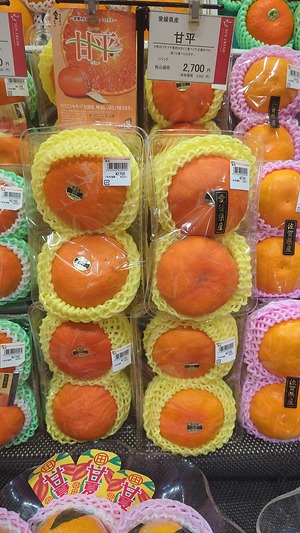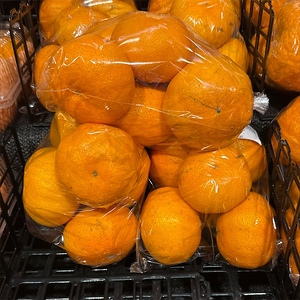


Kanpei Oranges
Estimated Inventory, lb : 0
Description/Taste
Kanpei oranges are a medium to large mandarin in Japan, averaging 6.7 to 10.2 centimeters in diameter and 220 to 300 grams in weight. The variety has an oblate, flattened appearance with a broad middle and curved, even edges. Kanpei oranges are uniform in shape and feature thin, easily peeled skin that is sometimes prone to cracking and losing moisture quickly. The skin has a soft give when squeezed and is taut and tightly adhered to the flesh. The fruit’s surface also ripens to a dark orange hue and has a smooth, pebbled feel from the presence of sunken oil glands. Underneath the skin, the flesh is plump, dense, and firm, divided into 10 to 12 segments by thin membranes. The orange flesh also has a distinct crunchy, aqueous, and slightly chewy consistency and is mostly seedless, occasionally containing a few seeds. Kanpei oranges are celebrated for their succulent nature and should feel heavy for their size, indicating the presence of ample juice. Select fruits with moist, firm, and taut skin and avoid fruits with puffy skin. The variety is eaten fresh and releases a soft, refreshing, and fruity scent when peeled. Kanpei oranges have a high sugar content, ranging from 12 to 14 degrees Brix, and are primarily sweet, fruity, and floral with subtle acidity.
Seasons/Availability
Kanpei oranges are harvested in the mid-winter through early spring in Japan, typically between January and March. It is said the peak season for the variety occurs in February.
Current Facts
Kanpei, botanically classified as Citrus reticulata, is a Japanese variety belonging to the Rutaceae or citrus family. The mandarin orange cultivar is a specialty type exclusively grown in the Ehime Prefecture in Japan and was commercially released in the early 21st century. Kanpei oranges were created as a mid to late season variety with improved traits to replace older citrus varieties grown in the Ehime Prefecture. The cultivar is known by several names, including Ehime No. 34 and Ehime Queen Splash, and are only produced in small, limited quantities due to their challenging cultivation characteristics. Kanpei oranges are a premium fruit sold in Japan as a high-end gift reserved for fresh consumption. The variety is favored for its thin rind, crisp, juicy, and succulent flesh, and sweet flavor. Currently, Kanpei oranges are not commercially grown outside of Japan and are an anticipated seasonal delicacy sold in the late winter through early spring.
Nutritional Value
Kanpei oranges have not been extensively studied for their nutritional properties. Mandarin oranges, in general, are a source of vitamins A, B, and C. Vitamin A helps the body with overall organ health while vitamin C strengthens the immune system. B vitamins assist the body with converting food into energy, making new red blood cells, and regulating everyday brain operations. Oranges also provide fiber to stimulate the digestive tract and various minerals, including phosphorus, calcium, potassium, magnesium, iron, and zinc. Potassium balances fluid levels within the body, calcium supports bones and teeth, phosphorus helps make adenosine triphosphate or energy for the body, and iron develops the protein hemoglobin for oxygen transport through the bloodstream.
Applications
Kanpei oranges are known for their primarily sweet, subtly tangy flavor suited for fresh and cooked preparations. The variety is mainly reserved for eating out of hand as it is a rare fruit sold at premium prices. Kanpei oranges also bear a distinct crisp and juicy texture that is savored when consumed raw. The fruits are peeled and segmented into pieces, or it is sliced in half and the flesh is scooped with a spoon. Segments of the flesh are also served as a fresh topping over yogurt, cakes, tarts, and ice cream or they can be tossed into green salads and fruit medleys. Kanpei oranges are sometimes blended into juices, smoothies, and other beverages. While less common, the variety can be simmered into jams, jellies, marmalades, and syrups or cooked into various desserts and baked goods. Kanpei oranges pair well with maple syrup, honey, brown sugar, spices such as cinnamon, cloves, ginger, and nutmeg, and fruits including strawberries, bananas, mangoes, pineapples, and blueberries. It is recommended to immediately consume the oranges for the best quality and flavor. Kanpei oranges can dry out easily and should only be kept for 4 to 5 days. The oranges can be placed in a plastic bag and stored in the drawer of the refrigerator to help maintain freshness.
Ethnic/Cultural Info
Kanpei oranges were named for their flavor and shape. Historically, the variety was called Ehime No. 34 during research and development. After the oranges were selected for commercial release, they were given the brand name Kanpei. In Japanese, “kan” translates to “sweet” and “pei” is the pronunciation sound of the word for “flat.” The brand name Kanpei was created to highlight the variety’s unique attributes and the variety, in general, is being marketed by organizations within the Ehime Prefecture as a luxury orange with limited availability. Kanpei oranges are positioned as gifts for celebrations, and another brand of Kanpei oranges, known as Ehime Queen Splash, was established in 2016 to further enhance this luxury reputation. Ehime Queen Splash is the highest graded Kanpei oranges and only around 0.3% of the fruits meet the allotted requirements to be labeled under this name. Ehime Queen Splash oranges must have a diameter of 8 to 10.2 centimeters, a uniform shape, no damage, good coloring, and a sugar content of 13 degrees Brix or more.
Geography/History
Kanpei oranges are native to Japan and were developed at the Ehime Prefectural Fruit Tree Experiment Station, now known as the Ehime Prefectural Agriculture, Forestry, and Fisheries Research Institute. The variety was created from a cross between Nishinoka and Ponkan oranges in 1997, and in 1993, seedlings were grafted and planted for evaluation. The first fruits were successfully produced in 1997, and in 2000, they were named Ehime No. 34. The variety was tested and studied for several years before an application was submitted in 2005 for variety registration. Official registration was granted in 2007, and Ehime No. 34 was branded under the name Kanpei for commercial release. Kanpei oranges are only grown in the Ehime Prefecture and are an exclusive product of the region. The fruits are primarily cultivated in the cities of Yawatahama, Ikata, Uwajima, and Matsuyama and are produced in small quantities due to their challenging growing requirements. Today, Kanpei oranges are locally sold throughout the Ehime Prefecture and are also shipped to select high-end fruit shops and department stores in metropolitan cities across Japan. Kanpei oranges are also seasonally offered through online retailers. The Kanpei oranges featured in the photograph above were sourced through a department store in Tokyo, Japan.









